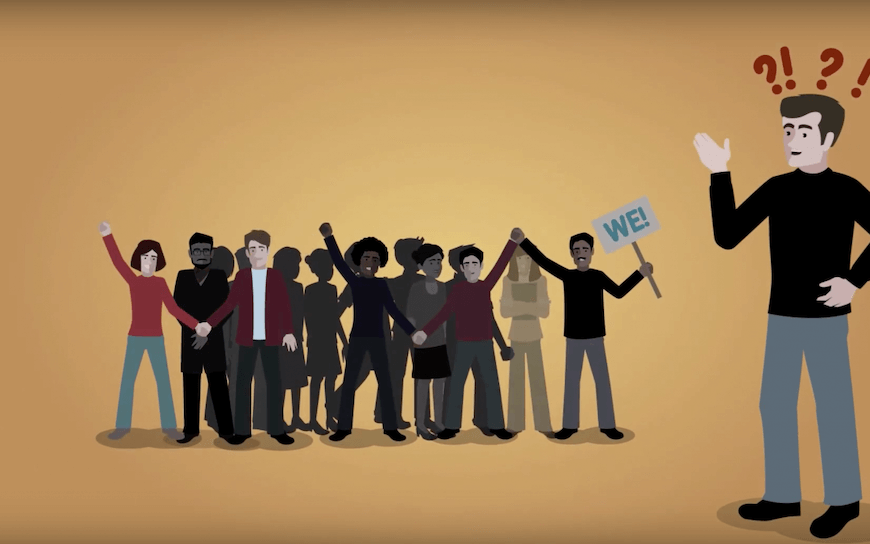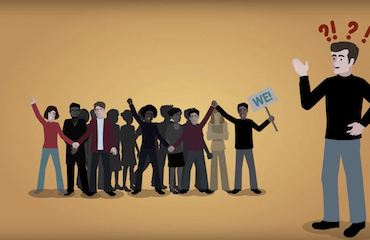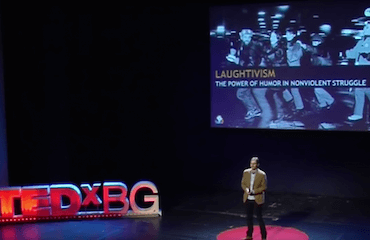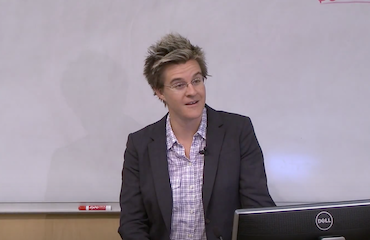
Democracy works because citizens are willing to engage with the government and create grassroots change. In our experience from working in more than 50 countries, building a nonviolent movement in your country is a crucial part of ensuring a successful transition to a democracy or to defend pillars of democracy in the situations where it may be under threat.
Building a movement to defend democracy may sound like “tough work” but here are CANVAS basics in how to do it – and you can learn those basics in less than an hour – meanwhile also having fun by watching amusing animating cartoons.
Subtitles in: Khmer, Arabic, French, Hebrew, Spanish and English
Step 1: Create Your Vision of Tomorrow
Every journey starts with the same step – by building a roadmap to decide where it is that you want to go. The first step in launching a successful movement for change is answering a single question: “How would society be different if we win?” Remember that your Vision should work not only for you or your friends but also cater to a larger spectrum of constituencies you want to mobilize and recruit for your movement!
Step 2: Build Unity
After you’ve cultivated a Vision of Tomorrow, it is important to use it to unite the different groups that you seek to mobilize. Building unity within the movement is vital to ensuring that those who oppose your movement cannot utilize a “divide and conquer” strategy. Learn how to foster a sense of community and cultivate group identity to ensure that your nonviolent movement can become a force to be reckoned with in this video!
Step 3: Understanding Power in Society and Pillars of Support
In order to create political and social change in a society, you must understand how to gain power and authority. Change is achieved by swaying institutions and organizations that we call “pillars of support.” These are organizations that are currently supporting the “status quo,” but can be swayed through societal pressure into becoming vehicles for change. Remember: no matter how “hopeless” a situation may seem, people can always learn how to wield social pressure to meet their goals – and change a society.
Step 4: Fight Fear and Apathy by Breaking its Core Engine
Two factors fuel the maintenance of the status quo: apathy of the population and the weaponization of fear in authoritarian environments. In both cases, there are large reasons why people obey – and learning how to break these obedience patterns can turn a large number of your fellow citizens into brave and committed activists.
Step 5: Plan your strategy and tactics
There are only two types of movements in history: those that are “spontaneous” – and those that are successful. Success means that you need plan, plan, and plan on various strategic and tactical points of your activities. So get serious and start planning how to address the right pillars in the right order to create effective nonviolent action.
Step 6: Communicate Effectively and Defeat Your Opponent’s Propaganda
Successful movements know how to communicate their messages to both people who they aim to turn into supporters and people who are supporting their opponent. Successful movements also know that once they start becoming successful their opponents will use propaganda against them. Learning how to communicate clearly and discredit your opponent’s propaganda is a “make-or-break” principle of nonviolent movement.
Step 7: Make Your Movement Cool, Witty and Funny
Humor and political satire are at the core of successful social change movements. Not only can you make creativity and humor part of your movement’s identity, but you can also use it to force your opponent into looking stupid or weak. Remember: you want your movement to be cool. Everybody wants to hang around cool people and cool activities.
Step 8: Understand and Use Social Media
In this day and age, new media has become vital for any activists seeking to grow their movement. Learn about how you can use new media for the benefit of your movement, as well as the potential negatives and dangers of its use.
Step 9: Prepare for Oppression – and Make It Backfire
Not all the societies in the world are made democratic. If you are fighting for democracy from within an autocracy, get prepared for your opponents to act oppressively. Successful movements know not only how to defeat fear and oppression, but also how to turn their opponents’ use of oppression against them. Learning to make oppression backfire makes you a jiu-jitsu master of social change.
Step 10: Always Finish What You Start
From the Arab Spring to human rights and anti-corruption campaigns, history is full of examples where movements successful initiated change – but haven’t been able to turn it into a long-lasting new normal. Your vision becomes reality only if your change becomes part of the institutions and culture. So it’s not only about winning – it’s also about how to facilitate transition after that victory.








